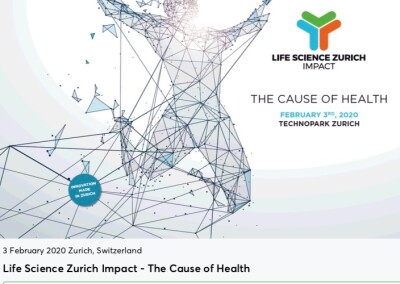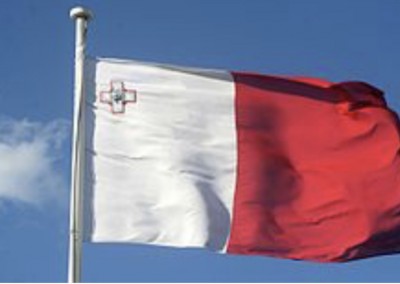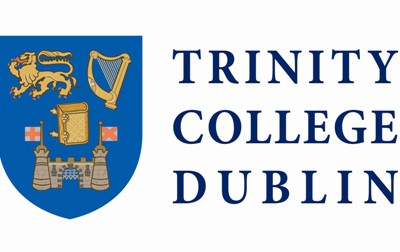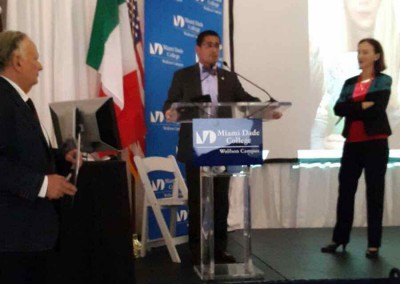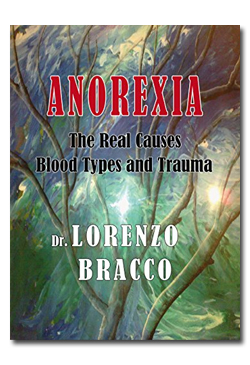
ANOREXIA. The Real Causes: Blood Types and Trauma
Italian Edition:
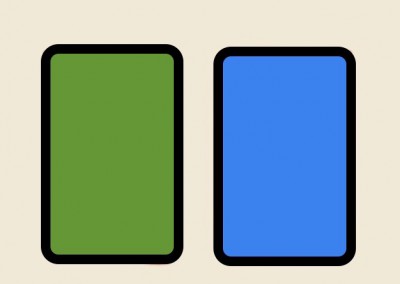
Inclusion criteria for group of girls suffering from anorexia and for control group of girls without eating disorders for research about Dr. Lorenzo Bracco’s new theory
ANOREXIA. The Real Causes: Blood Types and Trauma
by Lorenzo Bracco
The Cesare Pavese Award 2013 for nonfiction medical writing was awarded to Lorenzo Bracco for “Anorexia. The Real Causes”.
The jury’s motivation was the following: “Lorenzo Bracco presents an in-depth investigation in to the real causes of anorexia and offers innovative perspectives on understanding and treating this profound condition of existential distress”.
Italian Cultural Institute of Los Angeles and Italian Scientists and Scholars of North America Foundation
Bruno Conti (Professor of Chemical Physiology at The Scripps Research Institute in La Jolla CA and ISSNAF’s affiliate), Lorenzo Bracco (MD, Author) and Dario Voltolini (Journalist)
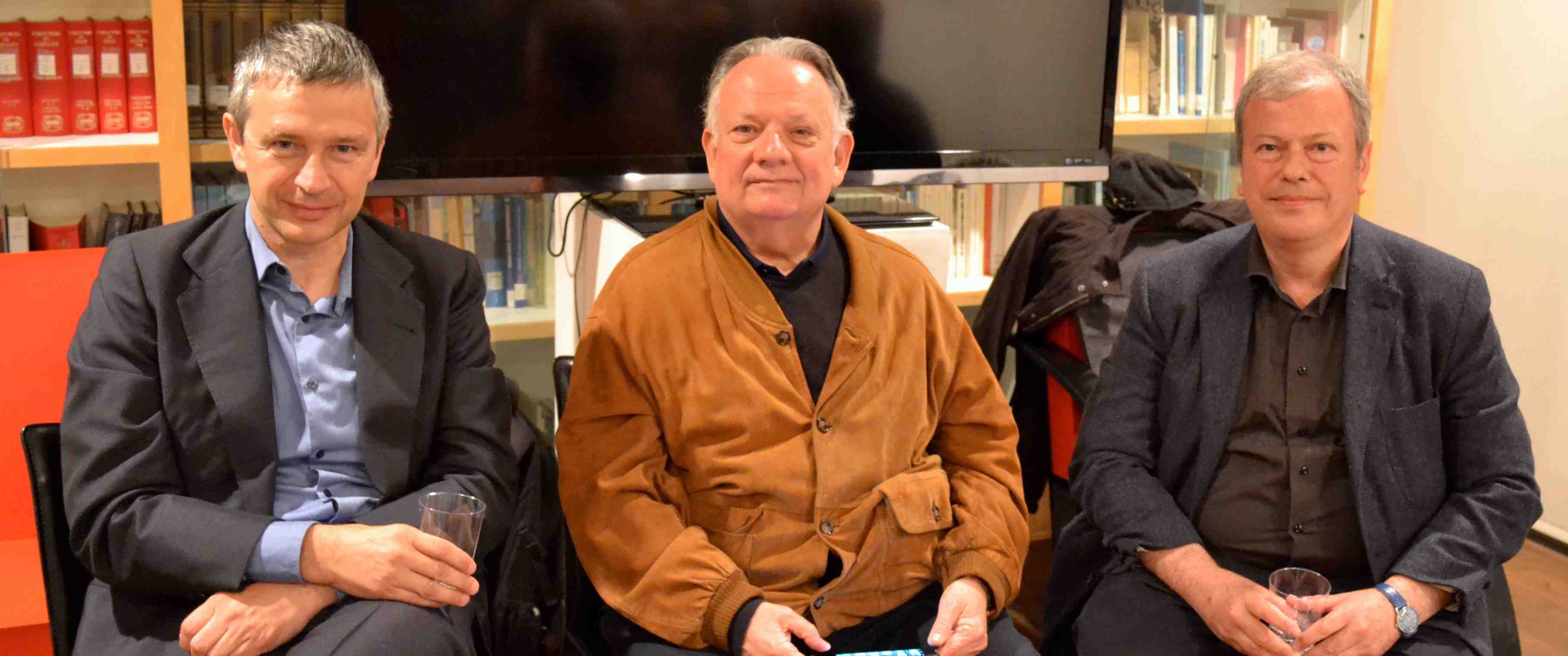
Back Cover – ANOREXIA. The Real Causes: Blood Types and Trauma
Anorexia integrates Dr. Peter Levine’s Somatic Experiencing® a naturalistic approach to the resolution of shock trauma, Dr. Laurence Heller’s NeuroAffective Relational Model™a model for the resolution of developmental trauma, Peter D’Adamo’s Blood Type Diet, and the Ecological Niche Diet®, Dr. Bracco’s diet based on the evolutionary ecological nature of nutrition and life style.
In addition, Dr. Bracco offers a new hypothesis: anorexics consistently show an unacknowledged disparity between the daughter’s blood group and that of her mother. Anorexia proposes an original solution for the prevention and treatment of female adolescent anorexia. Dr. Bracco’s unified theory and practical solutions frame known causes of anorexia within a pioneering perspective that brings forth new ways to solve this complex and dramatic problem.
Lorenzo Bracco MD, is an Italian physician living in Turin. He is a specialist in physical medicine and he holds a Diploma in Orthopedic Medicine and Manual Therapy from the University of Paris VI and a Diploma in Tropical Medicine from the University of Paris VII. He is also a psychotherapist, member of FF2P, France, and of the European Register for Psychotherapist (ERP, Vienna). He holds a Certificate of European Psychotherapy (ECP, Vienna), an International Diploma of Gestalt-Therapy (EPG, Paris), and a two-year Master in Brief Strategic Therapy (Arezzo). He is a Somatic Experiencing Practitioner and NeuroAffective Relational Model Practitioner. He is also a graduate in philosophy (University of Turin, IT).
DARIO VOLTOLINI’S INTERVIEW WITH LORENZO BRACCO
Voltolini. I know this book about anorexia well, an argument of great interest nowadays, and in addition to its scientific qualities, being a writer myself, I would say that it has a distinct narrative style.
The award ceremony takes place in Santo Stefano Belbo, a splendid location rich in history and culture as well as the birthplace of Cesare Pavese, internationally recognized author who introduced Italy to American literary masterpieces such as Melville’s Moby Dick. Dr. Bracco, you seem to beam with satisfaction at having been awarded the Cesare Pavese award.
Bracco. I am especially honored to receive this award which acknowledges the innovations in therapy for anorexia. Apart from traditional explanations that concern the family, the mother, the father, the anorexic daughter and the dynamic of the relationships between them, today, there are new perspectives that focus specifically on trauma therapy.
Voltolini. Currently, anorexia has become a highly topical issue and my impression was that modern research on eating disorders considers anorexia a consequence of more than one cause: psychological, social, medical and nutritional.
Bracco. I agree. Multiple causes are behind the onset of anorexia and eating disorders. This also explains how seemingly diverse therapies that each focus on just one of these concomitant causes can have a positive influence with regard to the development of the disorder. When we consider that multiple causes form the foundations for the onset of anorexia and eating disorders, if all of these causes are not properly identified, excessive importance may be placed on just one, though essentially, that one cause is not entirely to blame. The risk is that we begin placing blame, which is completely ineffective. For example, families where someone suffers from anorexia are sometimes held responsible when, in reality, each individual member of the family, parents, daughter and potential siblings, are unable to modify their behavior without the proper guidance required in order to do so. The paradox is that the blame placed on the family unit usually results in the intensification of the dysfunctional behavior.
Voltolini. Although it is a meticulous scientific work, the book is written in such a way that it is an engaging read for anyone. It is comparable to an episode of a first-rate TV medical series like Doctor House, for example, where the path to establishing a diagnosis and the appropriate therapy is much like the detective work of Sherlock Holmes. The investigation starts by distinguishing between two types of anorexia: anorexia in female adolescents, which manifests when a girl reaches adolescence (though it can recur later on in life), and anorexia independent of age and sex which can manifest at any stage in life in both sexes. Our main focus is anorexia in female adolescents, the form of the disorder which today, has a formidable social impact. When reading Dr. Bracco’s book, gradually, page by page, we discover how problems within relationships, especially those that arise between mothers and daughters, can be the result of trauma and how it is possible to intervene with specific trauma therapy.
Bracco. Yes, trauma therapy, particularly when trauma experienced at an early age is involved, meaning it took place during the phase that goes from the moment of conception to birth, or trauma experienced during the first stages of life that succeed birth. In order to survive a very dramatic event, like placental abruption or dystocia, the neurovegetative system of this human being at the very first stages of its life produces an extreme reaction in order to resolve the situation. The extreme, sudden stimulation of the neurovegetative system is most likely the cause of traumatization. These traumas, if improperly treated, leave their mark on the personality of the person in question and, as if in a domino effect, their relationship with the external world is altered. How can we not assume that a person’s relationship with his or her parents, especially with the mother, is affected? With regard to this topic, within my therapeutic proposal I have introduced NARM, the NeuroAffective Relational Model™. It is an integrated model of developmental age trauma therapy created and developed by Doctor Laurence Heller (see the book “Healing Developmental Trauma” by Laurence Heller and Aline LaPierre, North Atlantic Books, 2012). Dr. Heller, instead of using the term “character”, which usually implies a sense of permanence or immovability, opts for the expression “survival style”, which I find to be much more thorough and is the reason why I choose to use this term myself. A person’s survival style forms in order to survive one or more traumatic events. As far as strategy is considered, at the time the formation of this survival style may have been the best solution, however it no longer becomes appropriate in relation to a person’s lifestyle. In the book, NARM is not presented as it would be in a dissertation of sorts, but it gradually emerges throughout the course of the analysis.
Voltolini. Doctor Bracco is a physician and psychotherapist, member of the European Association for Psychotherapy (Vienna), Gestalt Therapist, Somatic Experiencing® Practitioner (trauma therapy according to Peter Levine), NeuroAffective Relational Model (NARM) Practitioner, who for years has continued on his own personal journey of discovery and research, including his work with Dr. Laurence Heller. On the topic of nutrition he has published the coveted “Di piatto in piatto. Viaggio nel mondo della nutrizione alla ricerca della giusta dieta” (From plate to plate. A journey through the world of nutrition in search of the perfect diet) and “DNE, Dieta della Nicchia Ecologica” (The Ecological Niche Diet®). In the latter publication, Dr. Bracco presents a balanced diet and lifestyle that respect the individuality of each and every human being, which are principles he regularly integrates in to his medical and psychotherapeutic practices. His extensive training seems perfectly tailored to a disorder such as anorexia where the medical, psychological and nutritional aspects are closely connected between them and where comprehensive therapy must accompany the person in question and their family through this evolutionary process.
Based on what we’ve said so far, one might think that this investigation on anorexia, conducted with considerable narrative ability which makes it extremely compelling, is a natural result of Dr. Bracco’s cultural background and therapeutic practice. However, when you read the book, you realize that aside from this, we are presented with an entirely new outlook with regard to the topic of anorexia. His fortuitous intuition with respect to his work motivated Dr. Bracco to investigate a cause that had never been revealed before.
Bracco. Yes. I am very proud of the fact that the Cesare Pavese Award, an award which recognizes the latest innovative research, has acknowledged my efforts in shedding light on new perspectives in order to further understand and treat this condition of serious existential distress. About twenty years ago, thanks to an episode that I won’t discuss now so as to not take away from the enjoyment of reading about it in the book, I realized the importance of a very specific biological difference that exists between mother and daughter as a contributory cause to female adolescent anorexia.
Voltolini. Please, tell us a little more about it, we are very curious.
Bracco. Ok, I’ll tell you about it in more detail.
What happened is a little bit like the apple that fell on Newton’s head. This is how it all started: I was studying Peter D’Adamo’s blood group diet O, A,B, AB, encouraged by a patient who wanted my opinion on it. Perhaps it was what I read on the blood group diet that sparked my curiosity to the point that, by pure chance I happened to ask the blood type of a young patient of mine who was accompanied by her mother. These two people were a mother and her anorexic daughter, although the latter refused to define herself as such, who, for years had had a problematic relationship. It was highly likely that the mother had had a difficult pregnancy, a gestation period that probably hadn’t gone very smoothly, meaning the first stages of life of her daughter, the patient in question, may have been problematic. This is when the “apple” fell on my head and as time passes, I receive ongoing confirmation that this represents a constant characteristic in all of these cases that involve anorexic daughters.
Voltolini. If I understand correctly, you are saying that there are many daughters who may have had difficulties during their first stages of life whilst in their mothers’ womb, however, without this characteristic, it is not enough to cause them to become anorexic.
Bracco. At that point in the story, something unexpected happened. When I had asked the daughter about her blood type, the mother, instead, vehemently intervened: “She doesn’t have the same blood type as me!”. “Curious”, I thought, instead of becoming irritated as a result of the mother’s abrupt interruption. From that moment on, I adopted the habit of asking every anorexic girl her blood type and her mother’s also. To my great surprise, the answer was always the same. After many years, I reached the following conclusion: the constant characteristic is that the daughter in question does not share the same blood type as her mother. I received further confirmation of this after observing families where there was more than one child. The same father, the same mother, the same context, but only one anorexic child: oddly enough it was always the daughter who did not have the same blood type as her mother. The difference in blood type, O, A, B, AB is, therefore, a key contributory cause, although it is not enough on its own, which leads to the onset of anorexia.
In standard research records, today, there is no information on blood types O, A, B and AB, not even, as far as I know, with respect to anorexia. In fact, within the first thirty years after the discovery of blood types, these were only taken into consideration in random, disparate research. Currently, if there aren’t any specific motives such as planned surgical interventions, anemia etc., the patient’s blood type does not appear at all in their medical records, not to mention the blood type of his or her mother. If it hadn’t been for that one episode, which I consider to be a stroke of luck, I myself would never have taken into consideration the difference in blood type between mother and daughter in relation to anorexia and all of my research that followed as a result, would never have existed.
Voltolini. What would you say to a woman that asks you: “If I give birth to a daughter that has a different blood type than I do, what will happen?”
Bracco. If she gives birth to a daughter who does not have her same blood type: the same situation could be considered from two different angles, which, as a result, have completely different consequences. One can lead to an increase in conflict between a mother and daughter that are biologically diverse. Let’s not forget that, in the case of a mother of blood type O, for example, that finds herself carrying a fetus of blood type A, if the group A blood is mixed with the O blood, this would be equivalent to a bad blood transfusion for blood group O. A bad blood transfusion can even be lethal. It is no surprise that, during pregnancy, a mother feels an enormous amount of anxiety and worry towards her unborn child, especially if the gestation period is characterized by one or more traumatic factors. The concomitant presence of traumatic factors intensifies the sensation of alarm towards the fetus with a different blood type and this diversity alone would become a trauma in itself. On the other hand, where there is an absence of traumatic events, or where they have been properly treated if these events have occurred, this disparity could become an advantage as opposed to a reason for alarm. In the end, having a daughter that is biologically diverse from oneself can actually be a very interesting aspect in a relationship. Experimenting with different perspectives through the daughter, in the case of different blood types, for example, allows the daughter the possibility to experience the process of feminine identification within a femininity that is diverse from her own, through the acknowledgement and respect of reciprocal differences.
In other words, in the case of anorexia, the daughter is not a person who is gratuitously hostile; rather, she is a person who, amidst endless obstacles, is searching for her own identity and respecting these differences may encourage the young girl in this discovery.

